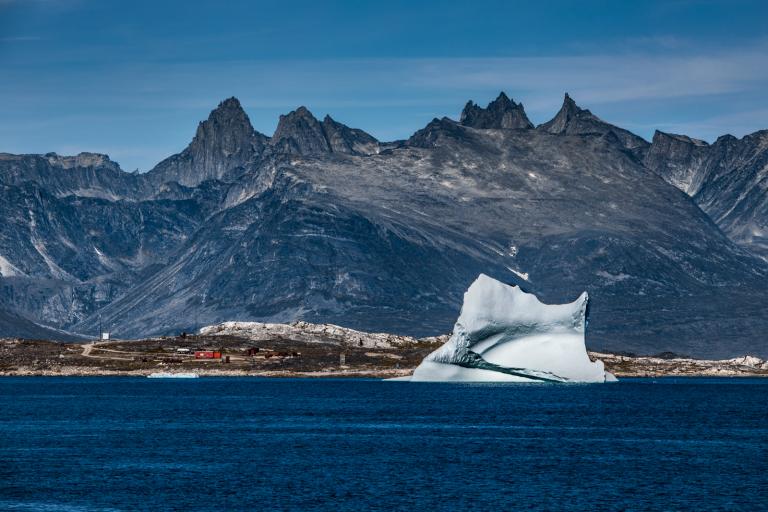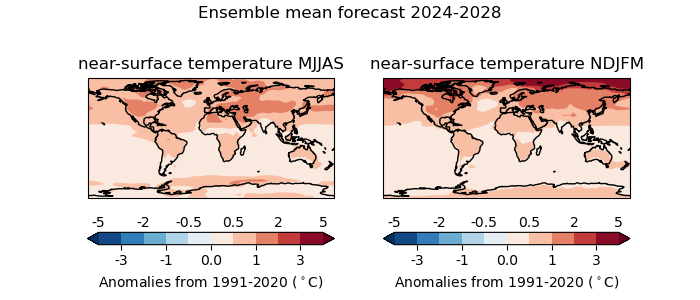Global temperature is likely to exceed 1.5°C above pre-industrial level temporarily in next 5 years
There is an 80 percent likelihood that the annual average global temperature will temporarily exceed 1.5°C above pre-industrial levels for at least one of the next five years, according to a new report from the World Meteorological Organization (WMO). This is a stark warning that we are getting ever closer to the goals set in the Paris Agreement on climate change, which refers to long-term temperature increases over decades, not over one to five years.
- 80% likelihood of at least one year temporarily exceeding 1.5°C between 2024-2028
- Short-term (annual) warming does not equate to a permanent breach of the lower 1.5°C Paris Agreement goal
- Likely that at least one of next five years will be the warmest on record, beating 2023
- Report highlights urgency of climate action

The global mean near-surface temperature for each year between 2024 and 2028 is predicted to be between 1.1°C and 1.9°C higher than the 1850-1900 baseline, according to the WMO report. It says that it is likely (86%) that at least one of these years will set a new temperature record, beating 2023 which is currently the warmest year.
There is a 47% likelihood that the global temperature averaged over the entire five-year 2024-2028 period will exceed 1.5 °C above the pre-industrial era, says the WMO Global Annual to Decadal Update – up from 32% from last year’s report for the 2023-2027 period.
The chance (80%) of at least one of the next five years exceeding 1.5°C has risen steadily since 2015, when such a chance was close to zero. For the years between 2017 and 2021, there was a 20% chance of exceedance, and this increased to a 66% chance between 2023 and 2027.
The update is produced by the UK’s Met Office, which is the WMO Lead Centre for Annual to Decadal Climate Prediction. It provides a synthesis of predictions from WMO designated Global Producing Centres and other contributing centres.
It was released to coincide with a major speech by United Nations Secretary-General António Guterres calling for much more ambitious climate action ahead of the G-7 summit in Italy 13-15 June.
“We are playing Russian roulette with our planet,” said Mr Guterres. “We need an exit ramp off the highway to climate hell. And the good news is that we have control of the wheel. The battle to limit temperature rise to 1.5 degrees will be won or lost in the 2020s – under the watch of leaders today.”
Mr Guterres also drew on supporting evidence from the European Union-funded Copernicus Climate Change Service implemented by the European Centre for Medium Range Weather Forecasts. This showed that each of the past 12 months has set a new global temperature record for the time of year.
Given these 12 monthly records, the global average temperature for the last 12 months (June 2023 – May 2024) is also the highest on record, at 1.63°C above the 1850–1900 pre-industrial average, according to the Copernicus Climate Change ERA5 dataset.

“Behind these statistics lies the bleak reality that we are way off track to meet the goals set in the Paris Agreement,” said WMO Deputy Secretary-General Ko Barrett. “We must urgently do more to cut greenhouse gas emissions, or we will pay an increasingly heavy price in terms of trillions of dollars in economic costs, millions of lives affected by more extreme weather and extensive damage to the environment and biodiversity.”
“WMO is sounding the alarm that we will be exceeding the 1.5°C level on a temporary basis with increasing frequency. We have already temporarily surpassed this level for individual months – and indeed as averaged over the most recent 12-month period. However, it is important to stress that temporary breaches do not mean that the 1.5 °C goal is permanently lost because this refers to long-term warming over decades,” said Ko Barrett.
Under the Paris Agreement, countries agreed to keep long-term global average surface temperature well below 2°C above pre-industrial levels and pursue efforts to limit it to 1.5°C by the end of this century. The scientific community has repeatedly warned that warming of more than 1.5°C risks unleashing far more severe climate change impacts and extreme weather and every fraction of a degree of warming matters.
Even at current levels of global warming, there are already devastating climate impacts. These include more extreme heatwaves, extreme rainfall events and droughts; reductions in ice sheets, sea ice, and glaciers; accelerating sea level rise and ocean heating.
“We are living in unprecedented times, but we also have unprecedented skill in monitoring the climate and this can help inform our actions. This string of hottest months will be remembered as comparatively cold but if we manage to stabilise the concentrations of greenhouse gases in the atmosphere in the very near future we might be able to return to these “cold” temperatures by the end of the century,” said Carlo Buontempo, Director of Copernicus Climate Change Service.
The global average near-surface temperature in 2023 was 1.45 °Celsius (with a margin of uncertainty of ± 0.12 °C) above the pre-industrial baseline, according to the WMO State of the Global Climate 2023. It was by far the warmest year on record fuelled by long-term climate warming which combined with other factors, most notably a naturally occurring El Niño event, which is now waning.
Last year’s global temperature was boosted by a strong El Niño. A new WMO Update predicts the development of a La Niña and a return to cooler conditions in the tropical Pacific in the near-term, but the higher global temperatures in the next five years reflect the continued warming from greenhouse gases.
Other key messages:
- Arctic warming over the next five extended winters (November to March), relative to the average of the 1991-2020 period, is predicted to be more than three times as large as the warming in global mean temperature.
- Predictions of sea-ice for March 2024-2028 suggest further reductions in sea-ice concentration in the Barents Sea, Bering Sea, and Sea of Okhotsk.
Notes to Editors
The Global Annual to Decadal Update is one of a suite of WMO climate products, including the flagship State of the Global Climate, which seek to inform policymakers.
The UK’s Met Office acts as the WMO Lead Centre for Annual to Decadal Climate Prediction.
This year there are 190 ensemble members from models contributed by 15 different institutes, including four Global Producing Centres: Barcelona Supercomputer Centre, Canadian Centre for Climate Modelling and Analysis, Deutscher Wetter Dienst, and the Met Office. Predictions are started towards the end of 2023.
Retrospective forecasts, or hindcasts, covering the period 1960- 2018 are used to estimate forecast skill. Also shown for the climate indicators are uninitialized historical simulations and projections from the World Climate Research Programme’s Coupled Model Intercomparison Project phase 6 (CMIP6). Confidence in forecasts of global mean temperature is high since hindcasts show very high skill in all measures.
The forecasts shown here are intended as guidance for Regional Climate Centres (RCCs), Regional Climate Outlook Forums (RCOFs) and National Meteorological and Hydrological Services (NMHSs). It does not constitute an official forecast for any region or nation, but RCCs, RCOFs and NMHSs are encouraged to appropriately interpret and develop value-added forecasts from this Climate Update.
The World Meteorological Organization (WMO) is a specialized agency of the United Nations responsible for promoting international cooperation in atmospheric science and meteorology.
WMO monitors weather, climate, and water resources and provides support to its Members in forecasting and disaster mitigation. The organization is committed to advancing scientific knowledge and improving public safety and well-being through its work.
For further information, please contact:
- Clare Nullis WMO media officer cnullis@wmo.int +41 79 709 13 97
- WMO Strategic Communication Office Media Contact media@wmo.int

